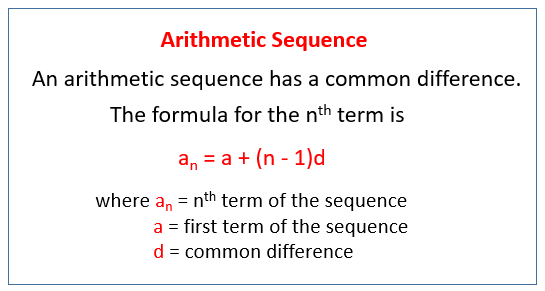
Continuing, the third term is: a3 ( a + d) + d. Since we get the next term by adding the common difference, the value of a2 is just: a2 a + d. For arithmetic sequences, the common difference is d, and the first term a1 is often referred to simply as 'a'. We offer tutoring programs for students in K-12, AP classes, and college. Since arithmetic and geometric sequences are so nice and regular, they have formulas.

SchoolTutoring Academy is the premier educational services company for K-12 and college students. Interested in math tutoring services? Learn more about how we are assisting thousands of students each academic year. When describing sequences, the following notation is standard.
#Math sequences series
A series is the sum of the terms of a sequence. When the sequence goes on forever it is called. A sequence is an ordered list of numbers. Suppose there is a set of numbers such as. A Sequence is a list of things (usually numbers) that are in order. The first step in determining the sequence is to arrange the terms in order. The Sequence Calculator finds the equation of the sequence and also allows you to view the next terms in the sequence. They can be defined by developing a rule that relates that constant to the pattern.
#Math sequences how to
The method how to find the formula for a linear, a.k.a arithmetic, sequence. The arithmetic sequence is the sequence where the common difference remains constant between any two successive terms.

As for finite series, there are two primary formulas used to compute their value. Formula for the n-th term of a linear sequence, using the difference method.

This is mostly used to perform substitutions, though it occasionally serves as a definition of arithmetic sequences.Īn arithmetic series is the sum of all the terms of an arithmetic sequence. Apart from these, there can be sequences that follow some other pattern. Then using the above result, as desired.Īnother common lemma is that a sequence is in arithmetic progression if and only if is the arithmetic mean of and for any consecutive terms. An arithmetic sequence is a set of ordered numbers that have a common difference between every two consecutive terms. There are a few special sequences like arithmetic sequence, geometric sequence, Fibonacci sequence, harmonic sequence, triangular number sequence, square number sequence, and cube number sequence.

The number of ordered elements (possibly infinite) is called the length of the sequence. Like a set, it contains members (also called elements, or terms). Proof: Let the sequence have first term and common difference. Mathematical Sequences (sourced from Wikipedia) In mathematics, informally speaking, a sequence is an ordered list of objects (or events). Ī common lemma is that given the th term and th term of an arithmetic sequence, the common difference is equal to. Let be the first term, be the th term, and be the common difference of any arithmetic sequence then. Because each term is a common distance from the one before it, every term of an arithmetic sequence can be expressed as the sum of the first term and a multiple of the common difference.


 0 kommentar(er)
0 kommentar(er)
